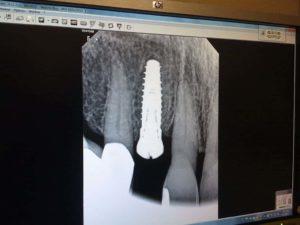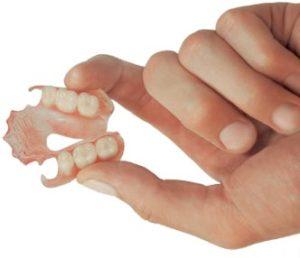Originally posted April 10, 2014
Sometimes – when advanced gum disease has substantially weakened the supporting bone, say, or when a tooth is so deeply infected that only a root canal can give the appearance of “saving” it – tooth loss is inevitable.
So what do you replace it with?
Once upon a time, bridges were our go-to solution. They can look and function beautifully. But placing a bridge means sacrificing large parts of two healthy teeth to anchor the false one between them. Additionally, as Dr. Dawn Ewing writes in Let the Tooth Be Known,
many craniosacral therapists believe it is not healthy or natural to tie teeth together. This prevents the natural ebb and flow the teeth have come to know. Bridging teeth, ties them together. Restricting the movement can stress the tooth and the related meridian.
These days, many say implants are the best solution for missing teeth. Often, you hear that, in terms of both look and function, implants are “just like regular teeth.” (This can be a bit of a problem, though, as one 2013 study in the British Dental Journal noted.)
Still, as with any kind of invasive surgery, the choice to get implants is one to take seriously – despite how cavalierly the procedure is treated in slick TV spots for “same day implants” and things like the lightly viral video of a dentist extracting his own tooth and placing his own implant, all within the span of about a half hour.
Taking it seriously means knowing the facts about dental implants, both their benefits and their risks.
 The first thing to bear in mind is that not all implants are created equal. Most dentists use titanium, which they typically say is “non-reactive.” But if you have metal in your mouth – amalgam fillings, say, or porcelain fused to gold crowns – any additional metal sets the stage for oral galvanism or intensification of symptoms. Any time two or more metals are in the mouth together, saliva acts as a conduit. The electric currents and ionic flow between the metals has been shown to irritate the trigeminal nerve – the main cranial nerve system – blocking the flow of major acupuncture meridians, which can in turn lead to greater dysfunction throughout the body.
The first thing to bear in mind is that not all implants are created equal. Most dentists use titanium, which they typically say is “non-reactive.” But if you have metal in your mouth – amalgam fillings, say, or porcelain fused to gold crowns – any additional metal sets the stage for oral galvanism or intensification of symptoms. Any time two or more metals are in the mouth together, saliva acts as a conduit. The electric currents and ionic flow between the metals has been shown to irritate the trigeminal nerve – the main cranial nerve system – blocking the flow of major acupuncture meridians, which can in turn lead to greater dysfunction throughout the body.
This is why those biological dentists who place implants opt for ceramic. Zirconium is one of the most broadly biocompatible materials there is. Integrative dentist Dr. Michael Baylin describes some of the other benefits:
Ceramic implants retain less plaque and calculus than titanium resulting in healthier gums and overall health. The rough surface of zirconium integrates or attaches itself exceedingly well to the jawbone….
Highly stable, biocompatible, and resistant to scratching and corrosion, zirconia is similar in color to natural teeth, creating a more visually pleasing result. It has all the qualities of biocompatibility to make it a material of choice for dental implantation. Additionally, it resists high impact and is non-allergenic.
Still, not all biological dentists go the implant route.
For one, there is some concern with the effects of embedding any kind of inorganic material on a meridian. Every organ in your body is situated upon one of these 12 energetic pathways that run throughout the human body. (To learn more, explore with our interactive tooth meridian chart.) To place an implant is effectively to place a block on that tooth’s meridian, disrupting energy and information flow all along it – and all tissues, organs and cells associated with it.
Clinical observation has suggested that implants may be a factor in a wide array of serious inflammatory conditions, including cancer, autoimmune disorders and “enigmatic” illnesses such as CFS, MCS and fibromyalgia.
Another area of concern involves the condition of the soft tissue (gums) and bone supporting the implant. Most of the time, disease plays a role in tooth loss. If the cleansing and healing of these tissues are ignored, the implant is apt to fail. Other dentists and dental researchers have expressed some concern with a deepening of infection spurred by the implants themselves.
While much more research is needed on these and other risks, these emerging concerns at least suggest taking a slower, more holistic approach to the matter. The issues that gave rise to the initial infection and tooth loss should be addressed first. The decision to go with implants or not can wait while the healing goes on.
If you’ve been told you should remove certain teeth due to advanced gum disease, there’s one other factor to consider: whether extraction and implant will be more successful than trying to save the teeth. Recent research published in the Journal of the American Dental Association suggests not. The study found that “questionable” teeth in those who received proper periodontal care and consistent maintenance fared more than twice as well as implants. While the 15 year loss rate for implants was as high as 33%, the loss rate for natural teeth was 13.4% at most.
The results of this systematic review show that implant survival rates do not exceed those of compromised but adequately treated and maintained teeth, supporting the notion that the decision to extract a tooth and place a dental implant should be made cautiously.
After all, they note, “a tooth can be extracted and replaced at any time; however, extraction is a definitive and irreversible treatment.”
Other research has determined that the advertised success rates of implants – usually said to be in the neighborhood of 95% – don’t really reflect reality. “Evidence exists that the loss rate of implants is higher than that of natural teeth in clinically well-maintained patients,” noted this study’s authors.
 Fortunately, there are other options for replacing teeth. One that we – and our patients – especially like is the Valplast partial. These extremely lightweight, flexible, metal-free and aesthetically superb devices fit snugly in the mouth, gently clasping onto strong, healthy teeth. After just a few days’ wear, you hardly feel them. They effectively become like natural teeth.
Fortunately, there are other options for replacing teeth. One that we – and our patients – especially like is the Valplast partial. These extremely lightweight, flexible, metal-free and aesthetically superb devices fit snugly in the mouth, gently clasping onto strong, healthy teeth. After just a few days’ wear, you hardly feel them. They effectively become like natural teeth.
And they’re much less expensive than implants.
Ultimately, the choice of partial or implant – or bridge or nothing at all – is yours to make when the situation arises. As ever, it’s just important that you understand all the facts, risks and benefits, so you know what you can reasonably expect from each option and then make the choice that makes the best sense for you.
As Dr. Mercola has put it, you want to be VERY careful when replacing missing teeth.
Implant image by Michelle Ress, via Flickr